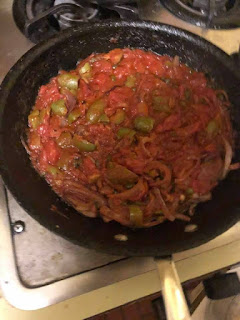Those readers who have been with Annalena in the past, know that Monday night , for about 7 months of the year, is soup night. The Guyman has rehearsal, comes home late, and dinner needs to be light, filling and tasty. So, it's soup. Annalena, with her seasonal bent, tries to design the soups that way: in September, there will be corn soup. In November, butternut squash. And she tries not to repeat herself.
This all becomes challenging in February and March. T.S Eliot wrote "April is the cruelest month." Clearly, he did not cook.
Confronted with a refrigerator full of root vegetables and winter greens this weekend, Annalena began to cast about for what to do. Cooking soup with root vegetables is easy. So is cooking one with winter greens. But we'd had them already this season. What to do that's new?
Years ago, Annalena learned how to make a Northern Italian soup called "polentina" (Little polenta). It's a corn meal based soup, where the amount of polenta is just enough to make it thick and smooth. You then add vegetables.
So, Annalena went to the cabinet to get the polenta. And she saw an almost finished container of rice. Hmmmmm. For reasons that will always remain obscure (the workings of Annalena's mind have defied many). She began to think of that Chinese classic, congee (or juk, depending on where you're from). Essentially, it's overcooked rice, with leftovers. Well, could Annalena combine the two?
Yes, she could, and she did. This is an original Annalena recipe and, for those who worry about this kind of thing, it's gluten free, vegan, and if you don't use the tofu, fat free. What's not to like?
First, you need some liquid. You can use water, you can use packaged broth of any kind, but why not try your hand at making it? Here's how Annalena made hers. She took 2 large leeks, and chopped them roughly (you can use a big onion too), a couple of stalks of ugly celery, two big ugly carrots, a couple of turnips, and a potato. All of these got chopped into irregular pieces, and covered with 2.5 quarts of water. Then she brought it to a boil, simmered for 20 minutes, and ... BROTH. If you make yours, do get the veggies out as soon as possible, because the longer they stay, the "greener your broth will be. That isn't necessarily a good thing.
Once you have your stock/broth, you are really just about done. The rest is easy. Go into your fridge and pull out the veggies you have, that aren't enough for a meal, or that are beginning to look snarky. Annalena found turnips, carrots, spinach, and dandelion greens. She took the carrots (two kinds), and turnips, and diced them into bite sized pieces and tossed them into the broth to simmer:
While this was happening, she cooked a pot of rice. Now, ragazzi, this is important. If you have cooked rice before, or read the instructions on thee side of a box of rice, you'll see that, for white rice, the "rule" is one part rice, for two parts water. For this soup, you're going to change that to 1:5, or even 1:6. What you are hoping to do, is to OVERCOOK the rice (you'll see this word in Italian sometimes, as stracotto. It doesn't mean overcooked to the point something is inedible, it just means it's more cooked than normal). You'll get rice like this:
You're also going to have a LOT of stuff in that pot. Annalena used one cup of rice, and she had enough "gruel" to feed her whole apartment.
What you're now going to do, is spoon off 2-3 cups of this stuff, rice and water. It will be hot, so work in small batches, and puree it in a blender. As you puree it, pour it into your broth and veggies:
Then, take the remaining rice, and either drain it or don't, and combine it with the other ingredients. Stir this all together, and make any necessary salt corrections you want. NOW, if you have greens from that fridge dive, add them. Spinach, chard, etc, will cook right there. Dandelion greens will need a few minutes, kale and collards, a lot longer. (Incidentally, you could push this more Venetian, by adding frozen peas instead of greens). Your soup looks like this, and you have a lot of it:
If you've gone through this recipe, you have not seen any olive oil, any animal products, any dairy, etc. So this soup is rather lean. For lunch, Annalena took a pound of tofu and seared it hard. The Guyman called the result "beancurd croutons," which is not wrong.
You should feel free to add what you want, if you in fact want to add anything. If you leave it simple, you have a winter tonic, but you will be hungry later.
And as St. Julia once said "that's all for today." More is coming ragazzi ed amici. Patienza.














